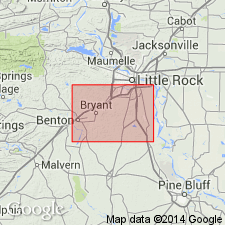
- Usage in publication:
-
- Mexia member*
- Modifications:
-
- Original reference
- AAPG geologic province:
-
- East Texas basin
Summary:
Pg. 530, 535, 559, 562. Mexia member of Wills Point formation of Midway group. Dark, thinly laminated or compact fossiliferous clays, 50 to 75 feet thick, of a fairly deep-water marine facies, with a thin glauconitic sand layer (VENERICARDIA BULLA zone) at base. [On p. 535 thickness of Mexia member is given as 215 feet.] Is lower member of Wills Point formation. Rests on Kincaid formation of Midway and underlies Wortham aragonite lentil; [GNC remark (ca. 1936, US geologic names lexicon, USGS Bull. 896, p. 1358): The USGS includes Plummer's Wortham, an 8- to 10-inch thick bed, in Kerens member of Wills Point formation. The Mexia as thus defined is overlain by Kerens member]. Age is Eocene.
Type locality: clay pit at brickyard, west edge of Mexia, Limestone Co., northeastern TX.
Source: US geologic names lexicon (USGS Bull. 896, p. 1358).

- Usage in publication:
-
- Mexia member
- Modifications:
-
- Areal extent
- AAPG geologic province:
-
- East Texas basin
Summary:
Pg. 25. Mexia member of Wills Point formation of Midway group. Lower member of Wills Point. In Texas, consists of dark thinly laminated or compact fossiliferous clay of fairly deep water marine facies. Constitutes about one-third of formation. Underlies Kerens member. Miss Gardner suggested the yellowish-gray foraminiferal clay beds exposed above the limestone of the Kincaid formation within the city limits of Little Rock might represent the Mexia member. Clay beds of the Mexia member type were not recognized in other parts of the area, nor were they identified in drillholes, hence no attempt at subdivision of the Wills Point was made during mapping.
Source: Publication; US geologic names lexicon (USGS Bull. 1200, p. 2484).
- Usage in publication:
-
- Mexia member
- Modifications:
-
- Biostratigraphic dating
- AAPG geologic province:
-
- East Texas basin
Kellough, G.R., 1959, Biostratigraphic and paleoecologic study of Midway Foraminifera along Tehuacana Creek, Limestone County, Texas: Gulf Coast Association of Geological Societies Transactions, v. 9, p. 147-160.
Summary:
Pg. 153-155, 160. Mexia member of Wills Point formation of Midway group. Thickness 85 feet in Tehuacana Creek section, Limestone County, northeastern Texas. Lower 36 feet contains abundant microfauna [Foramifera listed]. Underlies Kerens member of Wills Point formation; overlies Tehuacana member of Kincaid formation. The Mexia lies in [locally defined] POLYMORPHINA CUSHMANI to MARGINULINA TUBERCULATA zonule, [in upper part of] GLOBIGERINA COMPRESSA-DAUBJERGENSIS zone of Loeblich and Tappan (1957, p. 173-177). Age is early Paleocene (Danian; Midwayan Provincial Age).
Source: Publication; US geologic names lexicon (USGS Bull. 1200, p. 2484).
For more information, please contact Nancy Stamm, Geologic Names Committee Secretary.
Asterisk (*) indicates published by U.S. Geological Survey authors.
"No current usage" (†) implies that a name has been abandoned or has fallen into disuse. Former usage and, if known, replacement name given in parentheses ( ).
Slash (/) indicates name conflicts with nomenclatural guidelines (CSN, 1933; ACSN, 1961, 1970; NACSN, 1983, 2005, 2021). May be explained within brackets ([ ]).

